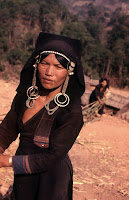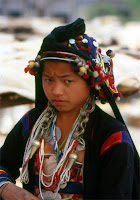Lancangjiang: The Mekong River in China
by Jim Goodman
In Southeast Asia it is popularly known as the Mekong—Mother of Waters. Its source lies high up on a bleak and barren slope of one of the Tangula Mountains in south central Qinghai Province, western China, a pool called Lasagongma Spring. Water from this spring flows into nearby glacial streams that merge and become the Mekong River. Called the Lancangjiang—the Winding River-- throughout its course in China, it flows 4350 kilometers through six countries and empties into the South China Sea. It is Asia’s 7th and the world’s 12th longest river, draining a basin of 810,000 square kilometers.
A few of the towns on the Upper Mekong played roles in the area’s history. Deqin was the center of a violent uprising against the Qing Dynasty government in 1905. Cizhong, in the southern part of Deqin County, is the site of a Catholic church established by French missionaries in the 19th century, rebuilt here in 1921 after its original further south at Cikou was destroyed in the 1905 rebellion. At Xiaoweixi, further downriver in Weixi County, was the other French mission church and its original building still stands. North of Xiaoweixi, above Kanpu, is Shuoguosi, the southernmost Tibetan monastery, erected in the 17th century during the reign of the Kang Xi Emperor, who often patronized Tibetan Buddhism.
Lying north of the Tropic of Cancer line, and with its mountains, high plains and plateaus, the Upper Mekong enjoys a temperate zone climate. Winters are cold but not bitterly so and except for occasional rain or snow generally dry and sunny. Spring is balmy and full of fresh flowers. The rainy season runs from around late May to October. Autumns are mild with good weather, dominated by a landscape of ripening rice fields and, in the higher altitudes, forests speckled with a bright range of tree leaf colors.
A mélange of different ethnic minorities has been living along the Lancangjiang for a couple thousand years, long before the Han even discovered the area. From its source in eastern Qinghai down through Shangrila County in northwest Yunnan, Tibetans dominate the population. They are part of the Khamba branch that inhabits eastern Tibet, historically famous for its resistance to governments both in China and in Lhasa.All that is just history now and in fact the Tibetans in Shangrila County have always gotten along well with the Han. Large farms dominate the county’s high plains, requiring two or three families working together for two days to bring in the autumn harvest. To the north, however, the land is rougher and rockier, the farms much smaller. A single family can crop their own field in half a day. Here animal husbandry is more important. But in the past an epidemic could wipe out their animals and, faced with survival at stake, Deqin Tibetans raided the richer Shangrila farms, while Han and Naxi soldiers protected the Shangrila Tibetans from their wilder cousins up north: hence, the good relations in Shangrila.
Continuing downstream, the Naxi are the next ethnic minority, with many settlements along the river in Weixi County. In the past the Naxi rulers of Lijiang, further east, responsible for providing border security, stationed Naxi troops along the frontier. Some of these Naxi soldiers retired and stayed in the region to found the ancestors of the riverside towns and villages of contemporary times.
It was a frontier Naxi culture, without the dongba tradition or the sophistication of religious rites prominent in Lijiang. Yet in essence it resembled the Naxi culture of villages beyond the immediate vicinity of Lijiang. The brick houses on stone foundations with tiled roofs were the same. So were the traditional garments, the way of farming and the Confucian norms regulating family and society.
In the hills above the Naxi settlements lives the Lisu ethnic minority. They are predominantly a rural people, divided into three main groups: the Black Lisu of Deqin and Nujiang, the White Lisu of lower Nujiang and upper Baoshan, and the Flowery Lisu of Baoshan, Myanmar and northern Thailand. The latter are famous for their bright colorful garments and, in China, an annual festival wherein men climb a tall ladder of sharpened swords.
South of the Naxi settlements and east of the Lisu territory, the land is home to the Bai people, one of Yunnan’s largest and most important minorities. They ruled the province from the early 10th century to the Mongol conquest in 1253. Farming, fishing and trade made them the area’s most prosperous ethnic group. Skills in handicrafts, metalware production and marble goods also contributed.In the hills beside the Bai-inhabited plains and south of Dali Prefecture are sub-groups of the Yi, Yunnan’s largest ethnic minority. Historically, the Yi established the ancient Nanzhao Kingdom, contemporary to China’s Tang Dynasty, and today comprise over 25 sub-groups in Yunnan, as well as others in Sichuan, Guizhou and Vietnam. The traditional dress of the women, still preferred by most, varies considerably, from the flashy, bright, highly embroidered garments of the Duli sub-group west of Dali to the nearly all black ensembles of the Limi sub-group in Lincang. Continuing downriver, the next major ethnic group is the Lahu, nowadays resident in southwest Yunnan, northern Myanmar and northern Thailand. A reclusive people, they established self-sufficient villages in the hills, relying on swidden agriculture, hunting and gathering. They were so renowned at hunting that the Dai in the plains, and their relatives in Myanmar and Thailand, called them Museur, the word for ‘hunter’. Originally a matrilineal society, the Lahu later evolved a dual inheritance system, while women continued to be held in high esteem. Heads of female lineages lead group discussions in the villages and are the final arbiters on matters of tradition and custom.
The Wa ethnic minority also inhabits the hills west of the
Lancangjiang next to Lahu territory and over the border in northern
Myanmar. Unlike most hill people in
Yunnan, whose languages are from the Tibeto-Burman linguistic group, the Wa
language is Mon-Khmer. In the past they
were notorious for their headhunting custom.
They believed the skull of a freshly decapitated head possessed a
soul-force that would, when mounted in the fields, protect the crops for up to
two years. Spring was thus the season
for organized headhunting raids, usually as far from the home village as
possible.
Always conscious of revenge, Wa village compounds were fortified, with secret entrances, containing two or three hundred houses. The practice was eliminated in the 1950s and villagers began demolishing the fortifications. Opium cultivation ceased then, too and now the Wa grow maize, buckwheat and rice, the latter mostly turned into alcohol.
A smaller minority in southwest Yunnan, the Bulang, also
speak a Mon-Khmer language. Like the Wa,
they are considered the earliest inhabitants of this area. They are also the only Buddhist hill people. Buddhist Wa and Lahu villages do exist in the
region, but all the Bulang are Theravada Buddhists and they claim they got the
religion before the Dai. Every village
has a temple and it’s still the custom for boys to spend a short period as a
novice in the temple. The Bulang raise
the usual hill crops, but in recent times have concentrated more on tea
cultivation.
By the time the Lancangjiang passes through southern Pu’er Prefecture and Xishuangbanna, the elevations of both plains and hills on either side are much lower. Because they still rise a thousand meters or more above the plains, mountain settlements were historically remote and hill people’s culture developed relatively autonomously. The Akha, prominent in these hill areas, are a good example. Known as Aini in China and Akha among themselves and their counterparts in Myanmar, Thailand and Laos, they are officially classified as a branch of the Hani nationality. But besides clothing style differences, like the ornate women’s headdresses, the Akha differ from Hani in house types, agricultural methods and ritual celebrations, like the annual Swing Festival.
A smaller minority east of Jinghong, the Jinuo, remained
isolated until last century. In fact,
they were the last people in Yunnan officially recognized as a minority
nationality. Originally families lived
together in longhouses, but as modernization and development reached Jinuoshan,
they began opting for individual dwellings.
Tea cultivation dominates their economy now, but old traditions persist,
like the annual festival honoring the blacksmith, whose tools and metal
products they credit with lifting them out of poverty and barbarity.
Plains neighbors to all these hill folks along the lower Lancangjiang—the Yi, Wa, Lahu, Bulang, Akha, Jinuo—are the Dai. For the most part they are wet-rice cultivators and followers of Theravada Buddhism, like their ethnic relatives in Southeast Asia—the Shan, Thai and Lao. Most villages have monasteries and most males spend a period of their lives as a novice residing in the monastery. The Dai have their own alphabet, used for both religious and secular purposes, which historically enhanced their prestige as a literate people. Small animist Dai sub=groups still exist, their lifestyle only differing in religious practice. These include the very colorful Huayao Dai near the Red River in Yunnan and the White and Black Thai of Laos and Vietnam.
Modernization is progressing all along the Lancangjiang
basin, yet ethnic traditions have persisted.
Because of an environment of rough mountains and remote valleys, life
among the people for many centuries carried on mostly autonomously. They might suffer the interference of
periodic tax and labor conscription campaigns by local princes, but were
largely beyond the battlefields whenever war broke out in the region, even the
Muslim Revolt that ravaged central Yunnan in the 19th century.
Fundamental changes, from influences beyond their traditional horizons, began taking hold only about a century ago, principally with the construction of a vast road network that by now has extended to nearly every remote village. Prior to this, communication in many places was by trail and on foot and the only contact people had with the outside world was from the caravans passing through, bringing both goods and news.
Greater transportation links promoted integration with the modern world, access to schools, clinics and markets, while advances in communication, like cell phones and the internet, have accelerated that process. It has altered some aspects of traditional ethnic minority culture but has by no means undermined the whole of it. Traditions and customs survive because the people do not see them as antithetical to modern times, but as part of their identity. Ethnic pride among the peoples of the Lancangjiang has been a resilient characteristic and today makes the region as attractive as the wonderful scenery from which it sprang.
* * *
(adapted
from the opening chapter of my latest book—Peoples of the Greater
Mekong: The Ethnic Minorities, to be
published soon by World Scientific Publishing Co., Singapore)
















































